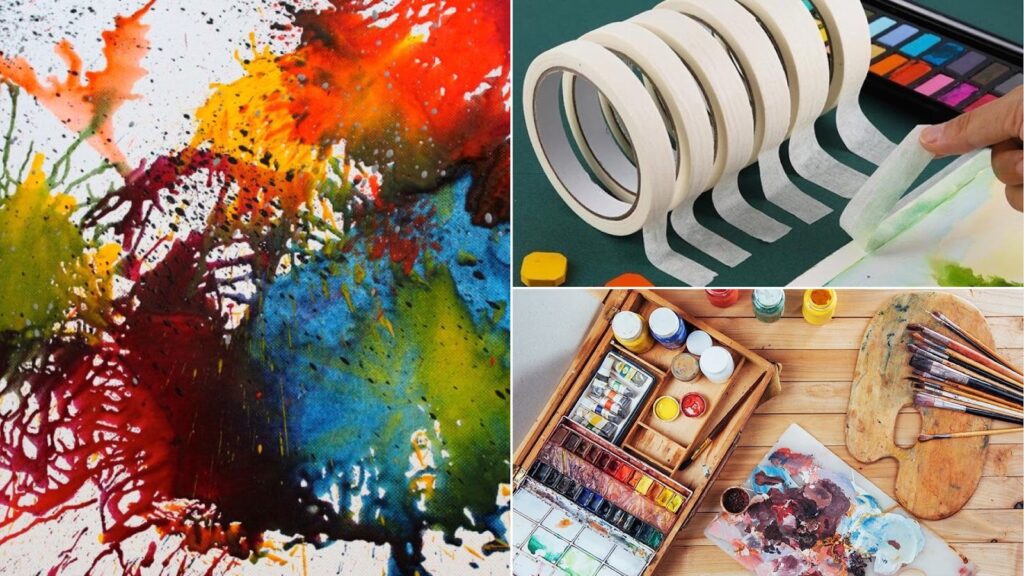Creativity is an artist’s greatest asset. But even the most talented among us could use a boost to unlock our full potential. That’s where clever hacks come in—expert techniques to elevate your art game from basic to extraordinary .
Source: Pinterest
The art hacks we are about to share will help you streamline your creative process and experiment with new techniques. They’ll equipment you with ideas to produce stunning works of art that showcase your unique style.
1. Splatter Paint
Using brushes or an old toothbrush to splatter paint is a fantastic way to add detail quickly. Whether it’s white stars in a night sky, a brush in a landscape, or freckles on a face, paint splatter can enhance any piece.
Source: Pinterest
Use opaque paint for visibility. You can also mix the paint with water so it’s liquid enough to sprinkle.
2. Make Tapes your Best Friends
There are countless ways to use tape in art. Whether adding an aesthetic border with crisp, clean lines or creating special designs, tapes are a choice tool to achieve versatility.
Source: Pinterest
Use painter’s tape to mask off areas you want to keep free of paint. Experiment with different shapes and patterns to add depth and interest to your artwork. Once you remove the tape, you will reveal striking contrast and clean edges that make your work stand out.
3. Speed Up Drawings with Toned Paper
Using mid-range color papers like Strathmore Toned or Toned Gray offers unique sketching possibilities. This provides the middle value, so you can focus on highlights and shadows.
Source: Pinterest
It saves time and allows for a broad range of values, making your drawing more dynamic. Consider using dark media to push darker values and white pencil or other light media to add highlights.
4. Perfecting Straight Lines
Painting straight lines can be tricky and using the ruler flat on the paper often leads to smudges. Instead, hold a ruler at an angle so the brush ferrule is against it, then drag your brush along the ruler to create a straight line.
Source: Pinterest
Alternatively, use your finger as a guide along the edge of the pad to keep your brush steady. These methods help achieve clean, straight lines.
5. Watercolor Pencils for Sketching
A graphite pencil can show through your watercolor paintings if you’re heavy-handed. Instead, use watercolor pencils for sketching your outlines.
Source: Pinterest
Watercolor pencils are water-soluble and will blend seamlessly into your painting, eliminating any visible lines. This technique ensures a clean and professional finish.
6. Enhancing Watercolors with Gouache
Gouache is a great tool to have in your arsenal to enhance watercolor pieces. While watercolor is transparent, gouache is opaque and perfect for adding solid layers.
Source: Pinterest
It allows you to add highlights and details on top of dark colors, giving your painting more depth and vibrancy. Use gouache to punch up your watercolor paintings and create striking contrast.
7. Blending Charcoal for Realistic Drawings
Blending charcoal effectively can create realistic and smooth transitions in your drawings. Use a round paintbrush to smooth out the grainy look of the charcoal and fill in the white bits of paper.
Source: Pinterest
For larger areas, use a tissue in a circular motion. For small details, blending stumps are ideal. Use a circular or sweeping motion, lifting the stump at the end of the stroke, to avoid uneven blending.
8. Use of Color Theory
Understanding color theory can significantly enhance your art. Using complementary colors can make your artwork pop and analogous colors create harmony. On the other hand, split complementary colors add contrast without being jarring.
Source: Pinterest
Playing with color temperature can also convey mode; warm colors suggest energy, and cool colors evoke calm. Experimenting with these combinations can bring new depth to your pieces.
9. Experiment with Different Mediums
Don’t limit yourself to just one medium as mixing different mediums can produce unique textures and effects. For example, you can combine watercolor with ink or acrylic with pastels.
Source: Pinterest
Using different tools like palette knives, sponges, and even kitchen items can lead to unexpected and exciting results. This exploration can add a rich variety to your artwork.
10. Digital Tools for Traditional Artists
Even if you primarily work with traditional media, digital tools can be incredibly useful. Apps like Procreate or Adobe Fresco can help you plan compositions and experiments with color schemes without wasting materials.
Source: Pinterest
Digital drawing tablets allow you to refine your skills and try new techniques. Integrating digital and traditional methods can expand your creative horizons.
11. Making Large Spaces Approachable
A blank sketchbook page can be intimidating. Break down this barrier by sectioning your pages into smaller squares and rectangles.
Source: Pinterest
Focus on creating one small drawing at a time. This approach makes the task less daunting and allows you to experiment with different ideas and techniques within each section.
